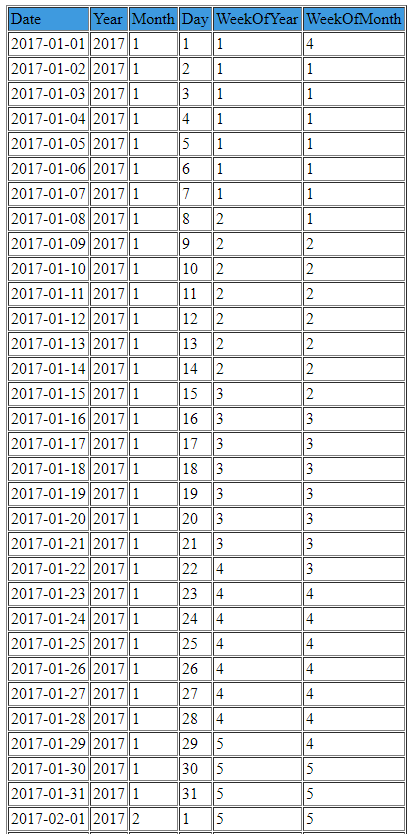Selamlar,
Bugün sizlere rapor yapanların çok işine yarayacak bir stored procedure paylaşıyor olacağım. Temel amacı vereceğiniz tabloyu HTML formata sizin istediğiniz html style yapısında dönüştürmek ve html output oluşturması
Stored Procedure Create Scripti
CREATE PROCEDURE [dbo].[spCustomTable2HTML] (
@TABLENAME NVARCHAR(500),
@OUTPUT NVARCHAR(MAX) OUTPUT,
@TBL_STYLE NVARCHAR(1024) = '',
@HDR_STYLE NVARCHAR(1024) = '')
AS
-- Author: Ian Atkin (ian.atkin@ict.ox.ac.uk)
-- Description
-- Stored Procedure to take an arbitraty temporary table and return
-- the equivalent HTML string .
-- Version History
-- 1.0 - Initial Release For Symantec Connect (Sept 2011)
-- @exec_str stores the dynamic SQL Query
-- @ParmDefinition stores the parameter definition for the dynamic SQL
DECLARE @exec_str NVARCHAR(MAX)
DECLARE @ParmDefinition NVARCHAR(500)
--We need to use Dynamic SQL at this point so we can expand the input table name parameter
SET @exec_str= N'
DECLARE @exec_str NVARCHAR(MAX)
DECLARE @ParmDefinition NVARCHAR(500)
--Make a copy of the original table adding an indexing columnWe need to add an index column to the table to facilitate sorting so we can maintain the
--original table order as we iterate through adding HTML tags to the table fields.
--New column called CustColHTML_ID (unlikely to be used by someone else!)
--
select CustColHTML_ID=0,* INTO #CustomTable2HTML FROM ' + @TABLENAME + '
--Now alter the table to add the auto-incrementing index. This will facilitate row finding
DECLARE @COUNTER INT
SET @COUNTER=0
UPDATE #CustomTable2HTML SET @COUNTER = CustColHTML_ID=@COUNTER+1
-- @HTMLROWS will store all the rows in HTML format
-- @ROW will store each HTML row as fields on each row are iterated through
-- using dymamic SQL and a cursor
-- @FIELDS will store the header row for the HTML Table
DECLARE @HTMLROWS NVARCHAR(MAX) DECLARE @FIELDS NVARCHAR(MAX)
SET @HTMLROWS='''' DECLARE @ROW NVARCHAR(MAX)
-- Create the first HTML row for the table (the table header). Ignore our indexing column!
SET @FIELDS=''<tr ' + @HDR_STYLE + '>''
SELECT @FIELDS=COALESCE(@FIELDS, '' '','''')+''<td>'' + name + ''</td>''
FROM tempdb.sys.Columns
WHERE object_id=object_id(''tempdb..#CustomTable2HTML'')
AND name not like ''CustColHTML_ID''
SET @FIELDS=@FIELDS + ''</tr>''
-- @ColumnName stores the column name as found by the table cursor
-- @maxrows is a count of the rows in the table, and @rownum is for marking the
-- ''current'' row whilst processing
DECLARE @ColumnName NVARCHAR(500)
DECLARE @maxrows INT
DECLARE @rownum INT
--Find row count of our temporary table
SELECT @maxrows=count(*) FROM #CustomTable2HTML
--Create a cursor which will look through all the column names specified in the temporary table
--but exclude the index column we added (CustColHTML_ID)
DECLARE col CURSOR FOR
SELECT name FROM tempdb.sys.Columns
WHERE object_id=object_id(''tempdb..#CustomTable2HTML'')
AND name not like ''CustColHTML_ID''
ORDER BY column_id ASC
--For each row, generate dymanic SQL which requests the each column name in turn by
--iterating through a cursor
SET @rowNum=0
SET @ParmDefinition=N''@ROWOUT NVARCHAR(MAX) OUTPUT,@rowNum_IN INT''
While @rowNum < @maxrows
BEGIN
SET @HTMLROWS=@HTMLROWS + ''<tr>''
SET @rowNum=@rowNum +1
OPEN col
FETCH NEXT FROM col INTO @ColumnName
WHILE @@FETCH_STATUS=0
BEGIN
--Get nth row from table
--SET @exec_str=''SELECT @ROWOUT=(select top 1 ['' + @ColumnName + ''] from (select top '' + cast(@rownum as varchar) + '' * from #CustomTable2HTML order by CustColHTML_ID ASC) xxx order by CustColHTML_ID DESC)''
SET @exec_str=''SELECT @ROWOUT=(select ['' + @ColumnName + ''] from #CustomTable2HTML where CustColHTML_ID=@rowNum_IN)''
EXEC sp_executesql
@exec_str,
@ParmDefinition,
@ROWOUT=@ROW OUTPUT,
@rowNum_IN=@rownum
SET @HTMLROWS =@HTMLROWS + ''<td>'' + isnull(@ROW,'''') + ''</td>''
FETCH NEXT FROM col INTO @ColumnName
END
CLOSE col
SET @HTMLROWS=@HTMLROWS + ''</tr>''
END
SET @OUTPUT=''''
IF @maxrows>0
SET @OUTPUT= ''<table ' + @TBL_STYLE + '>'' + @FIELDS + @HTMLROWS + ''</table>''
DEALLOCATE col
'
DECLARE @ParamDefinition nvarchar(max)
SET @ParamDefinition=N'@OUTPUT NVARCHAR(MAX) OUTPUT'
--Execute Dynamic SQL. HTML table is stored in @OUTPUT which is passed back up (as it's
--a parameter to this SP)
EXEC sp_executesql @exec_str,
@ParamDefinition,
@OUTPUT=@OUTPUT OUTPUT
RETURN 1
GO
Kullanımı
DECLARE @HTML NVARCHAR(MAX) EXEC SpCustomTable2HTML 'Dates', @OUTPUT = @HTML OUTPUT, @TBL_STYLE = 'style="font:11pt" cellpadding="2" cellspacing="1" border="1" bgcolor="#FFFFFF"', @HDR_STYLE = 'style="f<a href="http://www.caglarozenc.com/wp-content/uploads/Sonuc.png" data-mce-href="http://www.caglarozenc.com/wp-content/uploads/Sonuc.png"><img class="alignnone size-full wp-image-1070" src="http://www.caglarozenc.com/wp-content/uploads/Sonuc.png" alt="" width="409" height="834" data-mce-src="http://www.caglarozenc.com/wp-content/uploads/Sonuc.png"></a> ont:12pt" bgcolor="#3E9ADF"' SELECT @HTML
Sorgu sonucunu html olarak kayıp edip açarsanız aşağıdaki gibi güzel bir yapı ile karşılaşırsınız. Örnekte kullandığımız Dates isimli tablomuz.
İnternette var aynı isimli hazır store procedure kodlarını kullanacak olursanız belki ouput değeri null geliyor olabilir bunun da sebebi sp içerisinde yer alan “SET @HTMLROWS =@HTMLROWS “ bölümünde NULL değerleri birleştirme yapmaya çalışması bu bölümü “SET @HTMLROWS =@HTMLROWS + ”” + ISNULL(@ROW,””) + ”” “ bu şekilde değiştirdiğiniz de sp’niz hata vermeden işlemini tamamlayacaktır.
Bir sonraki yazıda görüşmek üzere..

